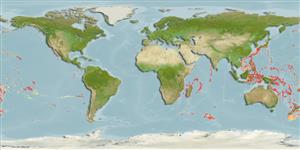>
Anguilliformes (Eels and morays) >
Nettastomatidae (Duckbill eels)
Etymology: Nettastoma: Greek, netta = duck + Greek, stoma = mouth (Ref. 45335); solitarium: From the Latin solitarius meaning solitary, alone, lonely, in reference to the isolated and widely scattered distribution of this species in the Indo-Pacific..
Environment: milieu / climate zone / depth range / distribution range
Ecología
marino bentopelágico; rango de profundidad 415 - 610 m (Ref. 40819). Deep-water
Indo-West Pacific: Kyushu-Palau Ridge, the Philippines, Australia, and the western Indian Ocean (Ref. 559). Reported from the Hawaiian Islands (Ref. 58302).
Tamaño / Peso / Age
Maturity: Lm ? range ? - ? cm
Max length : 46.5 cm TL macho / no sexado; (Ref. 40819)
Short description
Claves de identificación | Morfología | Morfometría
Six supraorbital pores, SO5 present. Lateral line pores 42-45. Median vomerine teeth somewhat enlarged. Posterior nostril above anterodorsal corner of eye.
Recorded on video tape outside the coelacanth caves at a depth of 278-340 m (Ref. 58472).
Life cycle and mating behavior
Maturities | Reproducción | Spawnings | Egg(s) | Fecundities | Larva
Paxton, J.R., D.F. Hoese, G.R. Allen and J.E. Hanley, 1989. Pisces. Petromyzontidae to Carangidae. Zoological Catalogue of Australia, Vol. 7. Australian Government Publishing Service, Canberra, 665 p. (Ref. 7300)
IUCN Red List Status (Ref. 130435)
Threat to humans
Harmless
Human uses
Herramientas
Special reports
Download XML
Fuentes de Internet
Estimates based on models
Preferred temperature (Ref.
123201): 2.3 - 11.5, mean 8.5 °C (based on 154 cells).
Phylogenetic diversity index (Ref.
82804): PD
50 = 0.5312 [Uniqueness, from 0.5 = low to 2.0 = high].
Bayesian length-weight: a=0.00089 (0.00036 - 0.00223), b=2.98 (2.77 - 3.19), in cm total length, based on LWR estimates for this (Sub)family-body shape (Ref.
93245).
Nivel trófico (Ref.
69278): 3.4 ±0.5 se; based on size and trophs of closest relatives
Resiliencia (Ref.
120179): Bajo, población duplicada en un tiempo mínimo de 4.5-14 años (Assuming tmax>10).
Fishing Vulnerability (Ref.
59153): Moderate vulnerability (37 of 100).
